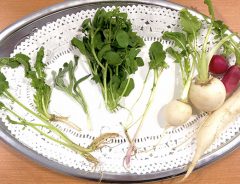
Tororo soba with assorted sticky foods | Photo by © cinnamonellie
Japan’s unique and healthy sticky foods: “neba neba” dishes worth trying
Related Article
-

Buy fresh salads, other tasty & healthy choices at Salad Stand vending machine in Shibuya Station
-

New Umami-Themed Pour-Over Style Dashi Bar Gives Rich And Relaxing Alternative To Coffee
-

Veggie Donuts for the Health-Conscious: OKdoughnuts
-

Start A Healthy, Happy New Year With These Seven Spring Herbs on January 7th
-

Cosme Kitchen Adaptation opening in Shibuya serves tasty vegan, gluten-free and raw food
-

Eat and learn: A plant-based café & food tech park has opened in Ginza!


Don't say never to neba neba
Neba neba (粘々 or ねばねば) means "sticky" in Japanese. Unfortunately, some people find neba neba foods unappealing on account of their appearance.
However, just like the saying goes, you shouldn't judge a book by its cover. Just because it looks a bit slimy, it doesn’t mean it tastes bad. If you judge it on its looks alone, you might end up regretting it.
I've found that mixing them with other foods, like rice or soba, for example, makes the overall appearance a lot more appealing!
Let me start by saying that these sticky foods are very good for your health and have a lot of benefits.
Have you ever wondered why Japanese people always have such beautiful skin? Well, one of the secrets is what they are eating (including these sticky types of foods!)
Healthy neba neba food recommendations
So, here are my recommendations for sticky, but healthy Japanese foods:
Nattō / 納豆 (fermented soybeans)
I have been a fan of nattō since the first time I tried it, so I find it odd that many people, especially foreigners, always making a weird face whenever I tell them I eat nattō on a daily basis.
Nattō is fermented soybeans and you can find them in many bean sizes (small, medium, large).
I am personally a fan of the medium and large-sized beans at the moment, but the first time I came here as a student, I always enjoyed the small bean type. I'd stir it up very well, and put it on my rice.
Although it also comes in individual packs, you'll typically see nattō in packs of three. The pack often include a packet of soy-based sauce and karashi (mustard) which you mix with the nattō.
I recommend nattō-maki to people trying it for the first time. You can also try it with rice until you get used to it.
A good source of dietary fiber and the enzyme nattokinase, nattō is most well-known for its benefits to intestinal health, blood circulation and heart health.
Since I started eating nattō regularly, I feel that my skin has become brighter and healthier, so I think I have benefited from it. I definitely felt a change within my body. I probably wouldn't function well if I skipped eating it for a long period. It has become a part of my routine!
I recommend eating one or two packs per day, but not more than that because eating it in exaggerated amounts will result in overconsumption of purines, selenium, and Vitamin K, all of which could be bad for you.
Okura / オクラ (okra or ladies' fingers)
For those who are unfamiliar with it, okra pods are slender and green and filled with small white seeds, which get sticky when you cook them. If you are just beginning your neba neba adventure, I think you should start with okra because it is probably the easiest one to eat. The slime contains soluble fiber, which is good for your health. Okra is also a good source of vitamins C and K.
You can microwave it, boil it, fry it, deep-fry it, even eat it raw. What I like to do is microwave it a little, then put a bit of soy sauce or ponzu (citrus-based sauce), then top it with katsuobushi (dried bonito flakes).
Tororo / とろろ (grated Japanese mountain yam: nagaimo / yamaimo)
Japanese mountain yams gets quite neba neba after grating or cutting them, but it doesn’t look bad at all. You can eat grated yamaimo with rice, mix it with some ponzu or soy sauce, and add chopped green onions or bonito flakes on top. It is delicious and has a lot of vitamins (B vitamins, vitamin C), minerals (potassium, iron, manganese) and is a great source of dietary fiber.
Mozuku / もずく (brown algae / mozuku seaweed)
Just like nattō, mozuku seaweed can usually be found in a set of three small packs. Usually seasoned in vinegar, and called mozuku-su もずく酢, it is slightly viscous but has a refreshing flavor. It's very good for summer, I’d say.
Another "neba neba" type of seaweed is mekabu. However, I feel that mekabu is stickier than mozuku, so if you are a beginner, I recommend trying out mozuku first.
Both mozuku and mekabu contain fucoidan, a dietary fiber shown to be effective in preventing or treating diabetes, hypertension and other adult lifestyle-related disease. They also contain calcium and other nutrients, so I recommend giving one of them a try!
Namatamago / 生卵 (raw egg)
Out of all the sticky foods I tried in Japan, the hardest one for me to eat was raw eggs.
I wasn’t a big fan of eggs from the beginning. Back in Europe, if I was cooking eggs, I’d just use the whites or would make an omelet with plenty of veggies, tomatoes and salty cheese (similar to feta cheese, but harder) in the oven, so the taste of eggs wouldn’t be that pronounced.
I remember my grandfather used to drink raw eggs saying they are good for your voice and have a lot of protein, but I just couldn’t comprehend it.
Eventually, I started eating more as I grew up, but eating them raw was a whole different story.
I came to like it after a year in Japan when I finally mustered up the courage to try tamago kake gohan 卵かけご飯 (Japanese rice topped with raw egg and a bit of soy sauce).
To be honest, I didn’t expect it to be so delicious!
Since I was already a convert to neba neba foods such as nattō, I didn’t find it that sticky. What's more, mixing it with hot rice actually cooks the egg a bit as well, which may make things easier for you. And if you are worried about the safety issue, don't! It is completely safe to eat raw eggs in Japan due to their stringent quality control.
Nameko / なめこ (nameko mushrooms)
My last recommendation is nameko mushrooms. They are not only very sticky and unique looking, but also have a gelatinous coat. This may look unappealing to some people, but nameko are full of minerals like calcium, and contain selenium and ergothioneine, which both have excellent antioxidant and anti-inflammatory properties. They're are also very good for your digestion.
I like putting them in the miso soup or, as a side dish, mixing them with daikon oroshi 大根おろし (grated daikon radish), green onions and a bit of soy sauce or ponzu.
Neba neba ending story
As a bonus, I will tell you how to combine a few of these wonderful neba neba foods in a single bowl to maximize their benefits.
I like tororo soba とろろ蕎麦 a lot. It's really easy to make and you can add all the neba neba things I've listed above. It is also healthy, low in calories, delicious, and perfect for hot summers!
I start by cooking soba noodles, then add tororo, nattō, shiso leaves, umeboshi (pickled plum), chopped green onion, sometimes raw egg, and nameko. Then, I pour in some concentrated tsuyu つゆ (noodle sauce) dilluted with water and sprinkle some nori seaweed on top.
I like to make the cold soba version, but you can also make hot tororo soba, which is great during cold winters.
Another way to combine these neba neba foods is by making a neba neba bowl of rice (Neba Neba Don ねばねば丼) with the ingredients you like the most.
As for mozuku-su, I usually eat it from the pack, because that’s what Japanese people usually do and it already has a vinegar flavor, so it is delicious just the way it is.
What is your favorite neba neba ingredient or dish?